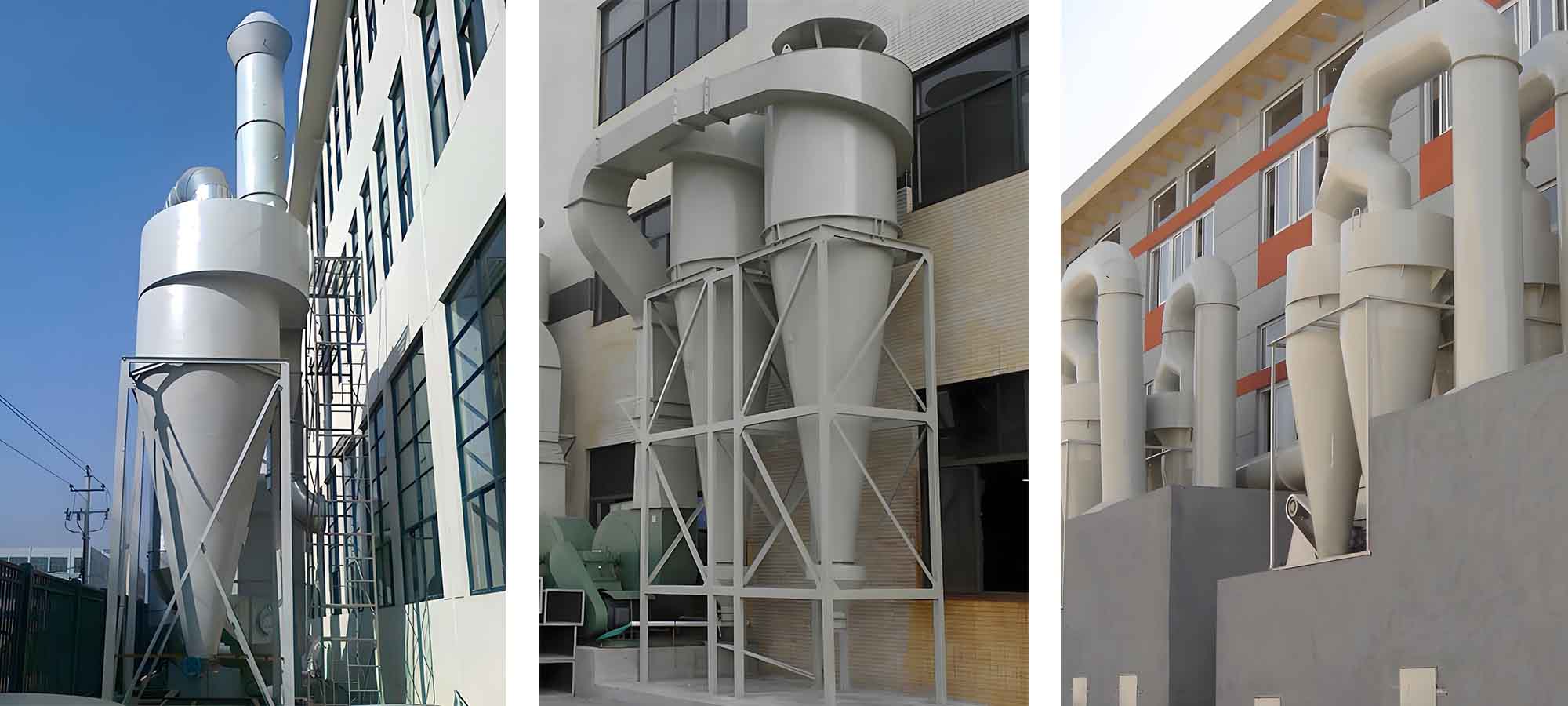Cyclone dust collector plays an important role in air pollution control. Each component has a specific size ratio. Any change of these proportions will significantly affect the efficiency and pressure loss of the dust collector. The key factors affecting the performance include the diameter, inlet size and outlet pipe diameter of the dust collector. Exceeding certain limits may turn beneficial factors into harmful factors. In addition, although some adjustments can improve the dust removal efficiency, it may also increase the pressure loss. Therefore, a balanced approach is essential.
1. Inlet Design of a cyclone filter
The air inlet is the key component of the cyclone dust collector, which can produce the vortex air flow required for dust separation. The area of tangential air inlet has a great influence on dust removal efficiency and pressure loss. Compared with the cross-sectional area of the dust collector, a smaller air inlet area can improve the tangential velocity, which is conducive to dust separation.
2. Cylinder Diameter and Height
The diameter of the cylindrical part is the basic size of the cyclone. The tangential velocity of rotating air flow is inversely proportional to the centrifugal force on dust particles. At the same tangential velocity, the smaller the diameter of the cylinder, the shorter the radius of rotation, which increases the centrifugal force on the particles and makes them easier to be captured. Therefore, it is advantageous to choose a smaller cylinder diameter. However, if the diameter is too small, it may cause particles to escape or block, especially when handling viscous materials.
For large air flow, using multiple cyclone filters in parallel is an effective solution. The total gas flow treated is equal to the sum of the capacity of each dust collector, and the resistance depends on the gas flow of a single dust collector. However, parallel configuration can complicate manufacturing and increase material requirements. They can also cause gas blockage, which increases resistance. Therefore, it is recommended to limit the number of parallel units.
The total height of cyclone is the total height of cylindrical part and conical part. Increasing this height can increase the rotational speed of the air flow in the dust collector, thereby improving the probability of dust separation. However, this may also cause fine particles to enter the internal vortex, thus reducing the efficiency. It is recommended that the height to diameter ratio of the cylindrical part is usually about 4:1.
The radius of the conical part decreases gradually, thus increasing the tangential velocity of the air flow. Compared with the cylindrical part, this design can generally improve the dust removal effect. Therefore, when the total height is fixed, increasing the height of the conical part can improve the separation efficiency. Generally, the cylindrical height is 1.5 times its diameter, and the conical height is 2.5 times its diameter for the best effect.
3. Outlet Pipe Design
The diameter and insertion depth of the air outlet pipe significantly affect the dust removal efficiency. It is very important to select the appropriate diameter of air outlet duct. Reducing the diameter of the air outlet pipe can narrow the rotation range of the internal vortex, making it more difficult for the dust to escape. However, this will increase the outlet speed and pressure loss. Although increasing the diameter of the air outlet pipe can reduce the pressure loss, it may cause a “short circuit” effect, resulting in the entry of uncollected dust into the air outlet. The recommended outlet duct diameter is 0.5 to 0.6 times the diameter of the cylinder.
The insertion depth of the outlet pipe is also critical. If inserted too shallow, dust-laden air may bypass the collector, reducing efficiency. If inserted too deep, it can increase friction losses and create opportunities for dust re-entrainment. The ideal depth is just below the inlet’s bottom.
4. Considerations for Combined Units
When the cyclone dust remover is combined, it shall be ensured that the dust laden air flow is evenly distributed. The air inlet, hopper and air outlet areas must be strictly isolated, and there shall be no leakage at the connection. Poor operation management, such as hopper leakage or delayed dust discharge, will seriously affect the efficiency and accelerate the wear of cyclone dust collector, thus shortening its service life.
According to the service conditions, the cyclone filter can be made of different materials, including steel, organic plastic, glass fiber, cast iron and cast steel. Special lining can enhance its wear resistance.
When linking cyclones in series, place lower-performance units downstream and higher-performance units upstream. Generally, avoid using identical cyclone models in series unless in high-concentration scenarios.
5. Continuous Improvement
To achieve low resistance and optimal performance, cyclone filter designs are continuously improved. Key modifications include:
- Changing the inlet design: changing from tangential inlet to rotary inlet can optimize the dust concentration distribution and reduce short circuit.
- Increase the number of units: transferring from a single unit to multiple units can effectively reduce the eccentric air flow and significantly reduce the resistance.
- Increase the dust removal channel: install the dust removal channel in the cylindrical and conical parts to prevent dust from re entering the air flow.
- Implement secondary separation device: adding devices such as reflective screen or intermediate hopper can help prevent dust from getting involved again.
- Enhanced outlet design: a secondary separator is installed at the outlet to improve the collection effect of fine dust by using the powerful rotating flow of waste gas.
- Combine drag reduction characteristics: increase the characteristics of reducing resistance in cylindrical and conical space to further optimize performance.

By considering these factors and continuously refining designs, cyclone dust collectors can achieve greater efficiency and effectiveness in dust removal applications.For more information or inquiries, please feel free to contact us! We look forward to providing you with professional solutions and support.

